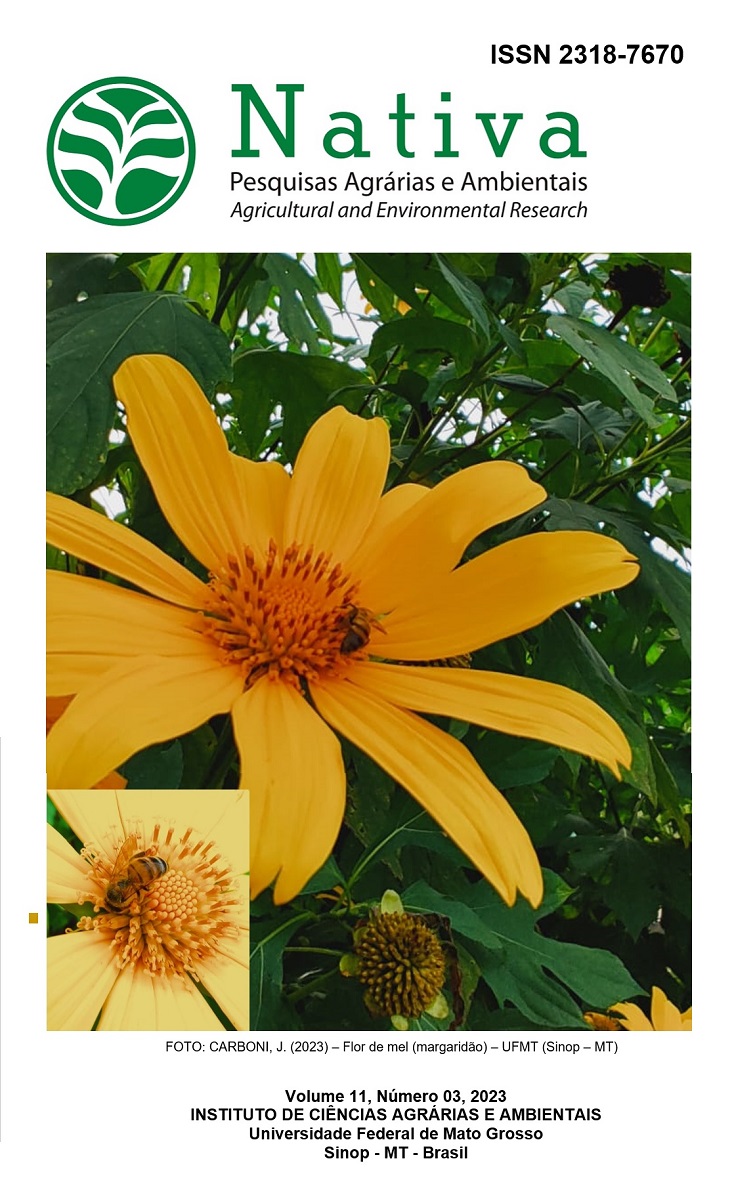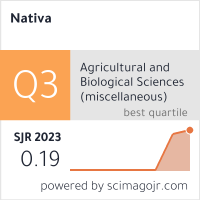ALCOHOLIC EXTRACTS OF Vitex agnus-castus AND Populus euphratica IN CONTROLLING Hyalomma anatolicum PARASITIZING LIVESTOCK
DOI:
https://doi.org/10.31413/nat.v11i3.16205Palavras-chave:
hard tick, biological control, combination of natural productsResumo
ABSTRACT: The study was conducted from the beginning of April 2022 to the end of December 2022 in Kirkuk governorate, Al-Huweija district. The study examined the alcoholic extracts efficacy of Vitex agnus-castus and Populus euphratica in controlling the hard tick Hyalomma anatolicum using the dipping method. All treated larvae died within 48 hours of treatment. The alcoholic extract of P. euphratica was more effective in killing tick nymphs at a 90 mg mL-1 concentration during the nymphal stage. The mortality rate was 100%. The lowest mortality rate was 67.7% at a concentration of 30 mg mL-1 after 96 hours of treatment. As for the V. agnus-castus alcoholic extract, the highest mortality rate at a concentration of 90 mg mL-1 was 93.33%, while the lowest was 66.66% after 96 hours of treatment. The alcoholic extract of the combination achieved a mortality rate of 93.33% at a concentration of 90 mg mL-1. The lowest concentration of 30 mg mL-1 resulted in a mortality rate of 46.66% after 96 hours of treatment.
Keywords: hard tick; biological control; combination of natural products.
Extratos alcoólicos de Vitex agnus-castus e Populus euphratica no controle de Hyalomma anatolicum
RESUMO: O estudo foi realizado desde o início de abril de 2022 até o final de dezembro de 2022 na província de Kirkuk, distrito de Al-Huweija. O estudo examinou a eficácia dos extratos alcoólicos de Vitex agnus-castus e Populus euphratica no controle do carrapato duro Hyalomma anatolicum usando o método de imersão. Todas as larvas tratadas morreram dentro de 48 horas após o tratamento. O extrato alcoólico de P. euphratica foi mais eficaz em matar ninfas de carrapatos na concentração de 90 mg/ml durante a fase ninfal. A taxa de mortalidade foi de 100%. A menor taxa de mortalidade foi de 67,7% na concentração de 30 mg mL-1 após 96 horas de tratamento. Quanto ao extrato alcoólico de V. agnus-castus, a maior taxa de mortalidade na concentração de 90 mg mL-1foi de 93,33%, enquanto a menor foi de 66,66% após 96 horas de tratamento. O extrato alcoólico da combinação atingiu taxa de mortalidade de 93,33% na concentração de 90 mg mL-1. A concentração mais baixa de 30 mg mL-1resultou numa taxa de mortalidade de 46,66% após 96 horas de tratamento.
Palavras-chave: carrapato duro; controle biológico; combinação de produtos naturais.
Referências
ABBOTT, W. S. A method of computing the effectiveness of an insecticide. Journal of Economic Entomology, v. 18, n. 2, p. 265-267, 1925.
ABDULHAMEED, Z. H.; ABDULMAJEED, M. I. Modern Trends in Pesticides and Insect Control. Part I. Cairo: Arab House for Publishing and Distribution, 1988. 572p.
AL-GHANAM, A. H. A. Sensitivity of some medical arthropods to the plant extract of Vitex aganus-castus and Populus euphratica and the chemical pesticide Lambda cyhalothrin. 78p. Master's thesis - College of Education for Pure Sciences - Tikrit University, Iraq. 2021.
AL-RUBAIE, H. M. K. The effect of extracts of Datura innoxia Mill on some aspects of biological performance of Musca domestica. 126p. PhD Thesis - College of Science, University of Babylon, 1999.
AL-YASIRI, M. A. K. Some life and environmental aspects of the hard tick – Rhipicephalus turanicus Pomerantzev (Acari: Ixodidae) and the effect of some extracts of colocynth seeds, Citrullus colocynth L. on its biological performance. 79p. Master's Thesis - College of Science, University of Al-Qadisiyah, 2011.
ASHOR, A. A. The effect of extracts of Clerodendrum inerma on some aspects of biological performance of Rhipicephalus turanicus (Acari; Ixodidae). Master's Thesis - College of Science, University of Al-Qadisiyah, 2012.
AS-SALAMI, W. M. The effect of extracts of Convolvulus arvensis L. and Ipomoae carrica (Linn) on the biological performance of the Schizaphis graminum. 111p. PhD Thesis - College of Science, University of Babylon, 1998.
CHRISTIE, S.; WALKER, A. F. Vitex agnus-castus L.:(1) A review of its traditional and modern therapeutic use. The European Journal of Herbal Medicine, v. 3, n. 3, p. 29-45, 1997.
FERNANDES, F. F.; D’ALESSANDRO, W. B.; FREITAS, E. P. S. Toxicity of extract of Magonia pubescens (Sapindales: Sapindaceae) St. Hil. to control the brown dog tick, Rhipicephalus sanguineus (Latreille) (Acari: Ixodidae). Neotropical Entomology, v. 37, p. 205-208, 2008. https://doi.org/10.1590/S1519-566X2008000200016
FERNANDES, F. D. F.; FREITAS, E. D. P.; COSTA, A. C. D.; SILVA, I. G. D. Larvicidal potential of Sapindus saponaria to control the cattle tick Boophilus microplus. Pesquisa Agropecuária Brasileira, v. 40, p.1243-1245, 2005. https://doi.org/10.1590/S0100-204X2005001200013
KHALAF, F. K.; AL-OBEIDI, B. M. R. Anatomical study of the vegetative parts and seeds of Vitex agnus-castus plant. Journal of Pharmaceutical Sciences and Research, v. 11, n. 3, p. 905-908, 2019.
GARCIA, M. V.; MATIAS, J.; BARROS, J. C.; LIMA, D. P. D.; LOPES, R. da S.; ANDREOTTI, R. Chemical identification of Tagetes minuta Linnaeus (Asteraceae) essential oil and its acaricidal effect on ticks. Revista Brasileira de Parasitologia Veterinária, v. 21, p. 405-411, 2012. https://doi.org/10.1590/S1984-29612012000400011
GRAINGE, M. Plant species reportedly possessing pest-control properties: an EWC/UH database. Resource Systems Institute, East-West Center, 1985. 240p.
HARBORNE, J. B. Phytochemical methods. 2nd Ed. New York: Chapman and Hall, 1984. 288p.
HEPTNER, V. G.; SLUDSKIJ, A. A. Mlekopitajuščie Sovetskogo Soiuza. Moskva: Vysšaia Škola [Mammals of the Soviet Union. Volume II, Part 2. Carnivora (Hyaenas and Cats)]. Washington DC: Smithsonian Institution and the National Science Foundation, 1992. p. 1-732.
HINKLE, N. C.; CORRIGAN, R. M. External parasites and poultry pests. In: SWAYNE, D. E.; BOULIANNE, M.; LOGUE, C. M.; et al. Diseases of Poultry. 14th Ed. London: John Wiley & Sons, 2020. p. 1135-1156. https://doi.org/10.1002/9781119371199.ch26
JONGEJAN, F.; UILENBERG, G. The global importance of ticks. Parasitology, v. 129, S. 1, p. S3-S14, 2004. https://doi.org/10.1017/s0031182004005967
KAPLAN, H. M.; TIMMENS, E. H. The Rabbit. A model for mammalian physiology and surgery. New York: Academic Press, 1972. 167p.
MATOVU, H.; OLILA, D. Acaricidal Activity of Tephrosia vogelii extracts on nymph and adult ticks. International Journal of Tropical Medicine, v. 2, p. 83-88, 2007.
RIBEIRO, V. L. S.; TOIGO, E.; BORDIGNON, S. A.; GONÇALVES, K.; VON POSER, G. Acaricidal properties of extracts from the aerial parts of Hypericum polyanthemum on the cattle tick Boophilus microplus. Veterinary Parasitology, v. 147, n. 1-2, p. 199-203, 2007.
RICARTE, L. P.; BEZERRA, G. P.; ROMERO, N. R.; SILVA, H. C. da; LEMOS, T. L. G.; ARRIAGA, A. M. C.; ALVES, P. B.; SANTOS, M. B. dos; MILITÃO, G. C. G.; SILVA, T. D. S.; BRAZ-FILHO, R.; SANTIAGO, G. M. P. Chemical composition and biological activities of the essential oils from Vitex-agnus castus, Ocimum campechianum and Ocimum carnosum. Anais da Academia Brasileira de Ciências, v. 921, n. 1, p. 1-11, 2020. https://doi.org/10.1590/0001-3765202020180569
RIOSE, A.; JONE, M.; ANDERSON, W. Preparation of water and alcoholic extracts in plants. Journal of Botany, v. 15, p. 155-159, 1987.
ROCKSTEIN, M. Biochemistry of insect. London: Academic Press, 1978. 430p.
ORBE, I.; PAZ, D.; PEJENAUTE, L.; PUENTE, A.; De ALDA, L. D.; YAGUE, S.; LETE, I. Medicinal herbs: Its therapeutic use in obstetrics and gynaecology. In: BIZZARRI, M. (Ed) Approaching Complex Diseases. Human Perspectives in Health Sciences and Technology, vol 2. Springer, Cham. https://doi.org/10.1007/978-3-030-32857-3_18
WALKER, A. R.; BOUATTOUR, A.; CAMICAS, J.-L.; ESTRADA-PEÑA, A.; HORAK, I.; LATIF, A. A.; PEGRAM, R. G.; PRESTON, P. M. Ticks of domestic animals in Africa: a guide to identification of species (Vol. 74). Edinburgh: Bioscience Reports, 2003. 221p.
WATHAH, I. F. The effect of temperatures and extracts of Datura metel L. on some biological aspects of the hard tick Hyalomma shulzei Olinev (Acari: Ixodidae). Master's Thesis - College of Science/University of Al-Qadisiyah, 2013.
WATTS JR, B. P.; POUND, J. M.; OLIVER JR, J. H. An adjustable plastic collar for feeding ticks on ears of rabbits. The Journal of Parasitology, v. 58, n. 6, p. 1105-1105, 1972.
WEI, W.; RENA, K.; YANG, X. W. New salicin derivatives from the leaves of Populus euphratica. Journal of Asian Natural Products Research, v. 17, n. 5, p. 491-496, 2015.
WIGGLESWORTH, V. B. The principle of insect physiology. London: Chapman and Hall, 1972. 434 p. https://doi.org/10.1007/978-94-009-5973-6
YOUSIF, S. M. H. The effect of some synergized plant extracts with titanium dioxide nanoparticles Tio2NPs and phenolic compounds isolated from some local plants in controlling two types of stored insects. PhD Thesis - College of Education, University of Mosul, 2022.
Downloads
Publicado
Edição
Seção
Como Citar
Licença
Copyright (c) 2023 Nativa

Este trabalho está licenciado sob uma licença Creative Commons Attribution-NonCommercial 4.0 International License.
Direitos Autorais para artigos publicados nesta revista são do autor, com direitos de primeira publicação para a revista. Em virtude de a aparecerem nesta revista de acesso público, os artigos são de uso gratuito, com atribuições próprias, em aplicações educacionais e não-comerciais.
A artigos publicados nessa revista, podem ser reproduzidos parcialmente ou utilizados como referência por outros autores, desde que seja cita a fonte, ou seja, a Revista Nativa.
Copyright for articles published in this journal are the authors, with first publication rights granted to the journal. The journal shows open access, and articles are free to use, with proper attribution, in educational and non-commercial.
The articles published in this journal may be reproduced in part or used as a reference by other authors, provided that the source is quoted.






